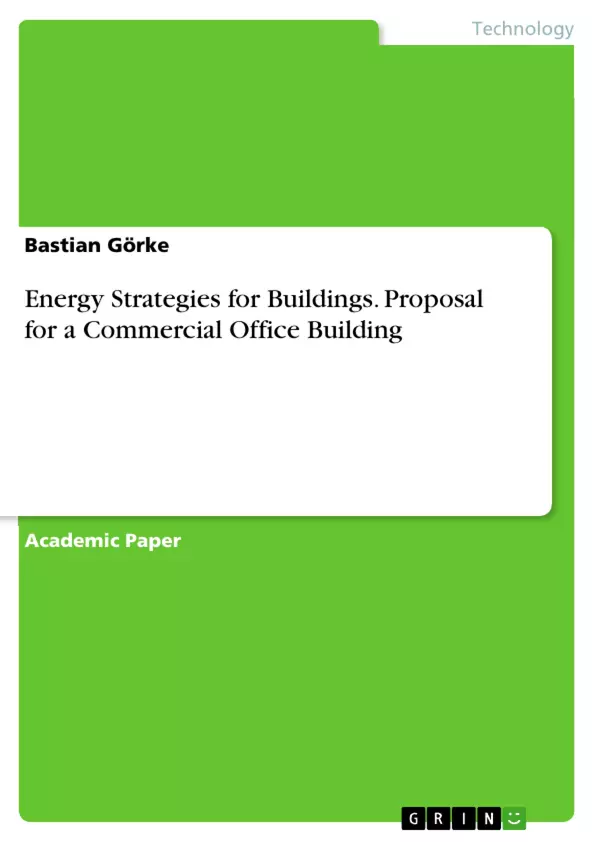This report aims at the energy and carbon emission reduction of the projected office building of the client.
Climate Change is a topic that recently gets a lot of attention throughout all levels of economy, society and policies. Policy targets are "set to achieve a reduction of harming carbon emissions. The pursuit towards these targets has become en vogue as it creates" green images, for example, of companies.
In order to reduce corporate emissions the company’s building stock can be designed carbon efficiently. Great consumers of energy in an office are the air-conditioning equipment and the lighting devices. Therefore these systems offer a high potential of carbon emission reduction. Progress of technology provides a great range of newly developed approaches to reduce energy demand and to minimize emission from energy generation.
Inhaltsverzeichnis (Table of Contents)
- Executive Summary
- Introduction
- Characterisation of Proposal A and possible modifications
- Strategy 1) Super Insulated
- Strategy 2) Passive Solar Design
- Strategy 3) Natural Ventilation
- Strategy 4) Daylighting
- Strategy 5) Cellular Office
- Carbon Emissions
- Passive Design Feasibility
- External environment
- Building orientation
- Building facade
- External solar shadings
- Internal heat gains
- Humidity Control
- Range of inside temperatures
- Alternative Low Energy Technologies
- Ground source heat pump (GSHP)
- Air-ground-coupling
- Air-slab-coupling
- Chilled Beams / Ceilings
- Displacement ventilation
- Natural and Artificial Lighting
- Conclusion and Recommendations
Zielsetzung und Themenschwerpunkte (Objectives and Key Themes)
This report aims to explore energy and carbon emission reduction strategies for a proposed office building. It analyzes the potential of five improved design strategies compared to an existing building proposal (Proposal A). The report also investigates the feasibility of passive design and alternative low-energy technologies for cooling and heating the building.
- Energy efficiency and carbon emission reduction in commercial office buildings
- Evaluation of passive solar design strategies
- Assessment of alternative low-energy technologies for heating and cooling
- Analysis of natural and artificial lighting systems
- Recommendations for a low-carbon approach to building design
Zusammenfassung der Kapitel (Chapter Summaries)
- Executive Summary: Provides a concise overview of the report's findings and objectives, highlighting the potential for significant carbon emission reduction and energy savings through the implementation of the proposed strategies.
- Introduction: Establishes the context for the report by discussing the growing importance of climate change mitigation and the need for carbon-efficient building design. The report focuses on reducing energy consumption in office buildings, particularly in air conditioning and lighting systems.
- Characterisation of Proposal A and possible modifications: Introduces the existing building, Proposal A, and highlights its strengths and weaknesses regarding energy efficiency. It then outlines five design strategies to enhance the building's performance, including super insulation, passive solar design, natural ventilation, daylighting, and a cellular office layout.
- Carbon Emissions: Compares the carbon emissions of different building types and emphasizes the significant potential for emission reduction through improved design and technology.
- Passive Design Feasibility: Examines the feasibility of implementing passive solar design principles in the building, considering factors such as building orientation, facade design, solar shading, internal heat gains, and humidity control.
- Alternative Low Energy Technologies: Explores various low-energy technologies for heating and cooling the office space, including ground source heat pumps, air-ground and air-slab coupling, chilled beams/ceilings, and displacement ventilation.
- Natural and Artificial Lighting: Analyzes the energy consumption of lighting systems and proposes strategies for maximizing natural light and reducing reliance on artificial light.
Schlüsselwörter (Keywords)
The report focuses on energy efficiency, carbon emission reduction, sustainable building design, passive solar design, low-energy technologies, office building design, thermal performance, building regulations, natural ventilation, daylighting, and lighting systems. The report aims to contribute to the development of more sustainable and environmentally friendly buildings, supporting the transition towards a low-carbon future.
- Quote paper
- Bastian Görke (Author), 2006, Energy Strategies for Buildings. Proposal for a Commercial Office Building, Munich, GRIN Verlag, https://www.grin.com/document/1030676



